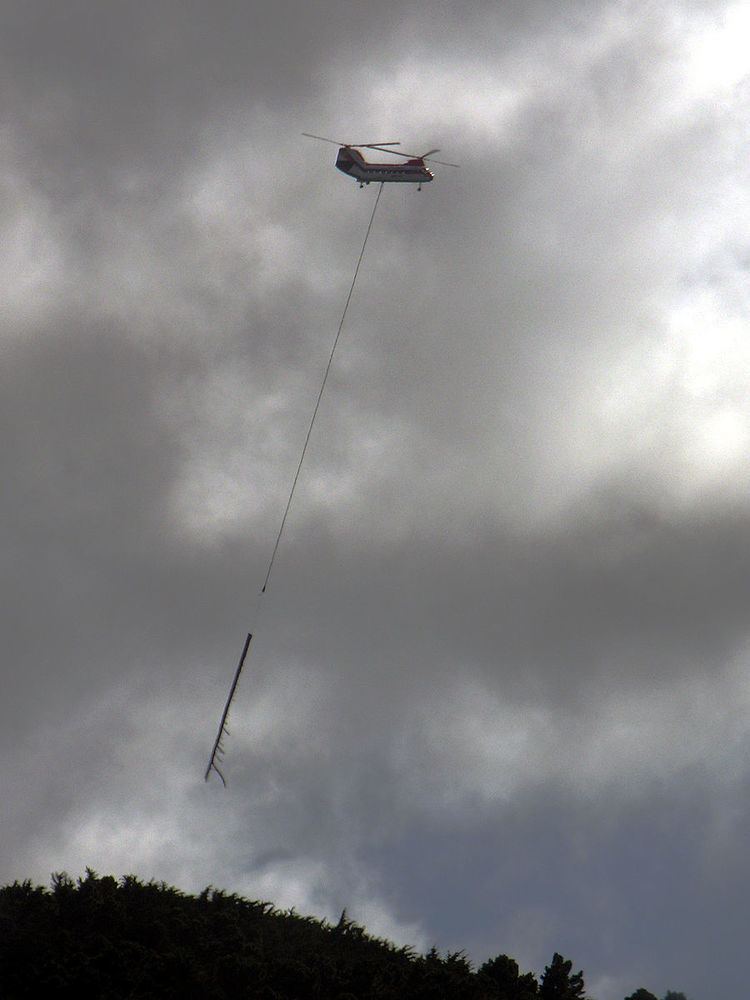 | ||
Heli-Logging, or Helicopter Logging, is a method of logging that uses helicopters to remove cut trees from forests by lifting them on cables attached to a helicopter. Helicopter logging is often used in inaccessible areas of forests. Because the use of helicopters reduces the level of infrastructure required to log in a specific location, the method also helps to reduce the environmental impact of logging. It also can increase the productivity in these remote areas.
Contents
History
Standing Stem Harvesting, a selective harvesting method within Heli-Logging, was invented by Philip Jarman of Port Alberni, British Columbia between May and October 1997. The initial harvesting equipment used wire rope or chokers to rig the stem and a modified external hook to engage the choker and lift the stem clear of the stump. In this way, the process of harvesting, which includes climbing, measuring, cutting, rigging, and lifting was pioneered by a single pilot flying a light utility helicopter. In 1998, the inventor supervised the building of an experimental grapple which was to be operated by a K-Max Lift Truck helicopter. However, because the K-Max had no hydraulics, it was necessary to design and install an externally mounted, jettisonable sled carrying a hydraulic power pack, to operate the grapple. Initial flight trials were carried out using the external hook and wire rope configuration on the 25th of April 1998. In late October 1998, a successful full-scale harvesting trial using a grapple designed by the inventor and funded by the timber licensee was carried out at Lunchtime Lake on Vancouver Island. Press releases and logging industry recognition followed. Patent applications in the United States and Canada were submitted and granted in 2001 and 2002 respectively.
In general, Heli-logging operations rarely use the light-weight, single-engine Kaman, and most operators will select one of three tested heavier twin-engine helicopter types: the 9000hp Sikorsky S-64F, the 3900hp MIL 8, and the 4400hp KAMOV Ka-32. These three types are most suited to Heli-logging because of structural and systems designs, for example, their twin-engine layout, and dual hydraulic systems. Although the S-64 is an excellent and powerful machine, relatively few have been made, certainly less than 50 total. On the other hand, hundreds of Ka-32s have been built, and the MIL-8s number in the thousands. The Kamov Ka-32A11BC is used for Heli-logging in mountainous areas of western Canada because of its availability and the fact that it is certified in Canada and Europe for commercial operations.
Process
Heli-Logging is also known as standing stem harvesting which is based on individual tree selection (ITS). The selection process is done by engineers and surveyors. The trees are selected based on demand for specific types and grades. Before the selection process is complete the selected trees are bored to check their reliability. The selected trees are then marked and their diameters are recorded. The diameter of the tree is measured at 1.3 meters above the ground. The sizes of the trees that are selected are controlled by two things. The minimum size is controlled by the economy while the maximum size is controlled by the capacity of the helicopter. Once the trees are selected they are climbed, the limbs are removed and the trees are topped. The length of the tree and the diameter at its top are then recorded. All the recorded data is then entered into a database which calculates volumes, weights, etc. The selected trees are then partially cut at the stem and supported by wooden wedges. The stem is then grappled by the helicopter and pulled until the wood breaks at the partial cut. The logged trees are then brought by helicopter to a predetermined roadside location or dropped into open water where they are collected.
Advantages
Heli-logging is efficient: a single S-64 Skycrane can extract 20 000 m3 (about 15,000 tonnes) of clean, undamaged timber per day. Conventional logging allows the stems to fall. On rocky terrains this often results in damage to the stems that makes them unusable. On steep terrains falling trees can slide downhill and become irretrievable. Heli-logging allows logging to take place in more remote places. It also allows certain trees to be logged that previously could not be due to their proximity to a structure or pipeline. These issues make conventional logging less efficient than heli-logging. Logging using helicopters is safer than conventional logging. Falling trees are dangerous for the loggers as well as for surrounding structures or utilities. Heli-logging also extends the logging season. This is due to the lack of snow load on a standing stem.
Helicopter logging ground crews will cut, clean, and mark the trees before the helicopter starts to work. Ground crews may be able to prepare less than 6 trees per day, and the helicopter will only be needed every few days. Since fewer roads need to be built to the site where the logging is taking place, and trees are extracted vertically, there is reduced damage to the surrounding trees and ground surface.
Research by Roberts, Ward and Rollerson done in 2004 shows that post-logging landslides are more common after conventional cable-based logging than heli-logging. Landslide rates following conventional logging are one and a half times more common than landslide rates following heli-logging.
Disadvantages
Although there is no direct cost from road construction or expansion, heli-logging incurs high costs. Operation of a helicopter as well as the selection processes and methods increase the cost. The use of a helicopter to transport the stems limits the size and weight of the selected trees more than equipment would using conventional logging.
